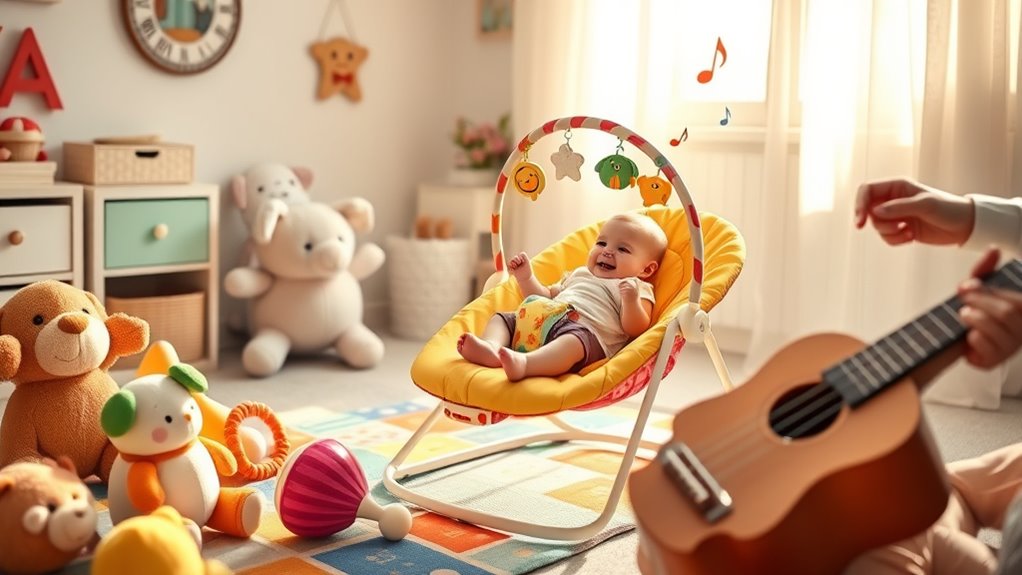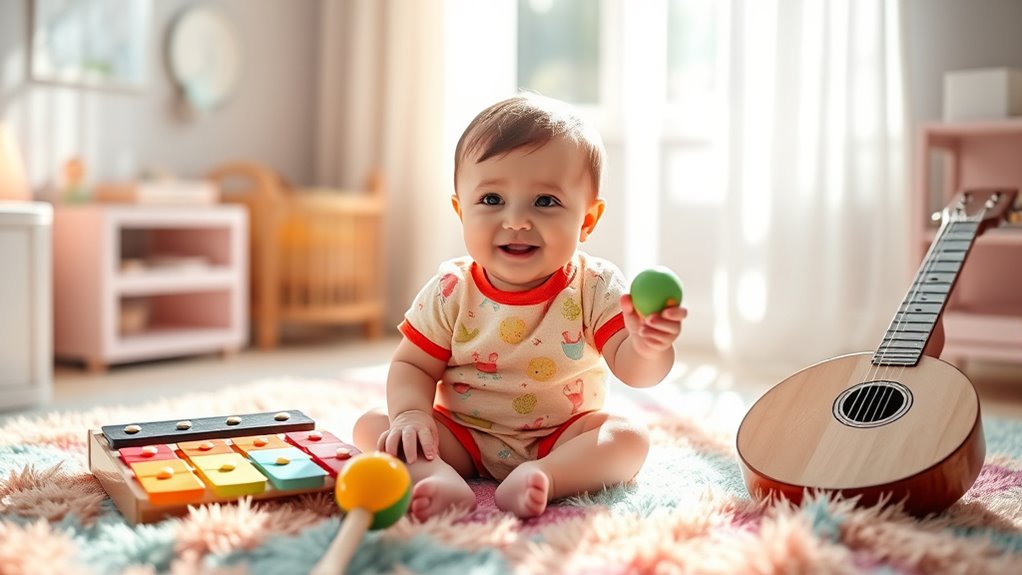For your baby’s music time, try soothing lullabies and gentle melodies to create a comforting environment. Incorporate interactive songs that encourage clapping and waving to enhance motor skills and social interaction. You can make mundane tasks fun by singing during diaper changes or bath time. Focus on simple rhythms and introduce diverse cultural music for varied auditory experiences. Engaging with your baby through music will foster emotional connections, and there’s a lot more to discover!
Key Takeaways
- Incorporate soothing lullabies for relaxation and bonding during newborn care routines.
- Use interactive songs with clapping and movement to engage infants and enhance motor skills.
- Select simple melodies and rhythms to captivate your baby’s attention and encourage language development.
- Explore music from different cultures to provide diverse auditory experiences and expand your baby’s sound recognition.
- Participate in musical activities together to strengthen emotional connections and create joyful shared memories.

Music is a magical tool that can significantly enrich your baby’s early development. When you introduce music into your child’s daily routine, you’re not just filling the air with pleasant sounds; you’re actively engaging in activities that enhance cognitive, social, and emotional growth. From the first lullabies you sing to your newborn to the interactive songs you share with your toddler, each moment spent in musical play lays the foundation for their future learning.
Music enriches your baby’s development, fostering cognitive, social, and emotional growth through joyful interactions and shared melodies.
For babies aged 0-6 months, soothing lullabies can work wonders. These gentle melodies help your little one relax and bond with you. You’ll notice how your baby responds to the rhythm and tone, creating a comforting environment that promotes emotional regulation. This early exposure to music nurtures their auditory cortex, making them more attuned to sounds and patterns, which is crucial for their cognitive development.
As your baby grows into the 6-15 months stage, it’s time to switch gears and introduce more interactive songs. Think of clapping, waving, or even simple dance movements. These activities not only enhance their motor skills but also foster social interaction. Engaging in music together encourages bonding and helps your child learn about social cues. Repetitive songs are particularly effective, as they reinforce language skills through action and comprehension.
Make music a part of your daily routines to provide structure and predictability. Whether you’re singing while changing diapers or incorporating songs during bath time, these moments can turn mundane activities into joyful experiences. Involving family members in these musical sessions can create a sense of community, making each song a shared memory.
Select music specifically designed for infants and toddlers. Look for simple melodies and rhythms that captivate their attention. You can even introduce music from different cultures to broaden their auditory experiences. Don’t underestimate the power of lullabies, either; these timeless tunes remain essential for soothing your baby and strengthening your bond.
Remember, your participation is key. Use facial expressions and gestures to enhance the musical experience, and encourage your baby to fill in words or actions during songs. This interactive approach not only builds emotional understanding but also strengthens the parent-child connection.
Ultimately, each song you share contributes to your baby’s cognitive and emotional development. Embrace this magical tool, and you’ll witness your child thrive in ways you never imagined.
Frequently Asked Questions
What Age Is Best to Start Music Time With My Baby?
You can start music time with your baby from birth! Early exposure to music helps with sensory development and bonding.
As your baby grows, around three months, they’ll begin vocalizing and imitating sounds, making it a great time to engage in musical activities. By introducing simple songs and rhythms, you’ll encourage their emotional expression and cognitive growth.
The earlier you begin, the more benefits you’ll see as they develop!
How Long Should Each Music Session Last?
For music sessions, aim for about 45 minutes or less.
Babies have short attention spans, so keeping it brief helps maintain their focus. Incorporate a mix of singing, movement, and simple instruments to keep things engaging.
You’ll want to adjust the length based on your baby’s mood and interest.
Are There Specific Instruments Suitable for Babies?
Absolutely, there are several instruments that are perfect for babies!
You can start with soft, colorful shakers like the Horner Baby Shaker, which fits perfectly in tiny hands. Maracas and egg shakers are also great for developing rhythm and coordination.
As your baby grows, consider introducing a rainstick or a Remo Baby Drum for soothing sounds and tactile fun.
These instruments not only entertain but also support your little one’s cognitive and motor skill development.
Can I Use Songs From Different Cultures?
Sure, why not? If you want your baby to grow up fluent in “Baby Babble” and “Cultural Cooing,” singing songs from different cultures is the way to go!
These tunes not only soothe but also spark language and cognitive development. Infants thrive on the delightful mix of familiar and new sounds, and you’ll be the superstar parent who introduces them to a world of musical adventures.
How Can I Encourage My Baby to Participate?
To encourage your baby to participate, try gently bouncing or swaying while you play music.
Imitate their sounds and engage in call-and-response singing to foster interaction.
Use age-appropriate instruments like egg shakers for exploration.
Incorporate music into daily routines, making activities like bath time fun.
Lastly, expose your baby to various music genres and cultural sounds to keep things interesting.
Your enthusiasm will inspire them to join in!
Conclusion
As you dive into these delightful melodies with your little one, remember that music is the heartbeat of childhood, resonating through laughter and joy. Each note you share becomes a thread in the tapestry of their early memories, weaving moments of connection and love. So, grab your instruments, sing loudly, and let the rhythm of your bond echo through the ages. Together, you’re not just making music; you’re crafting a symphony of early experiences that will linger long after the last note fades.









